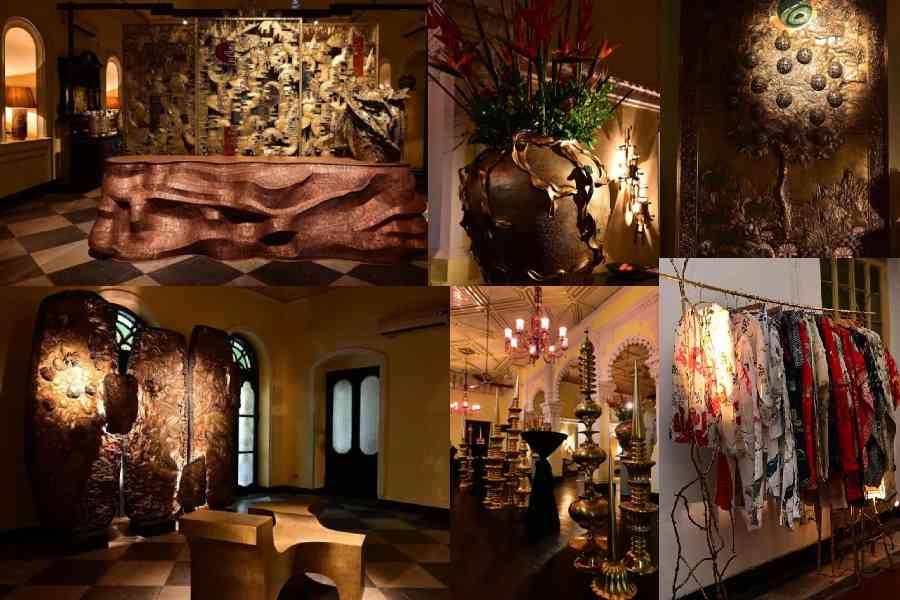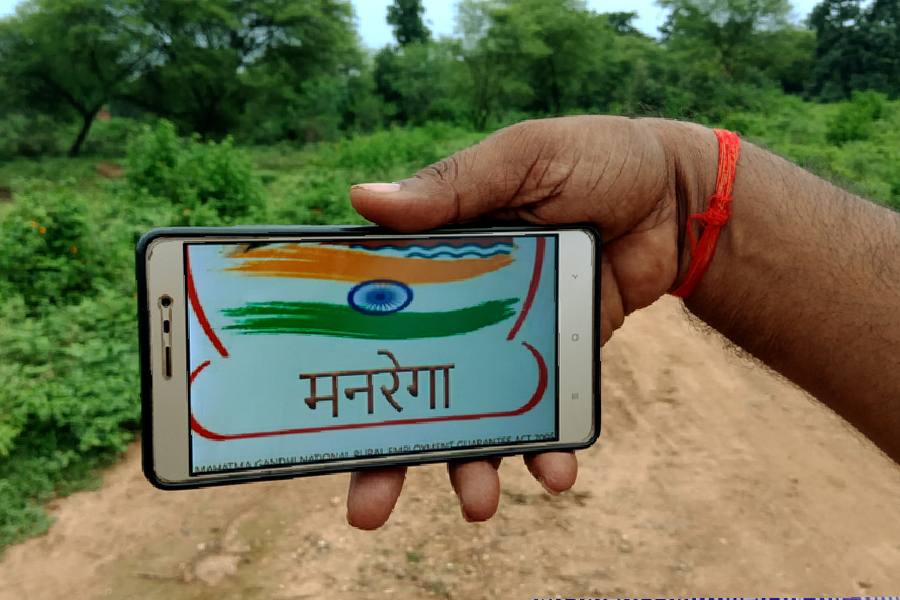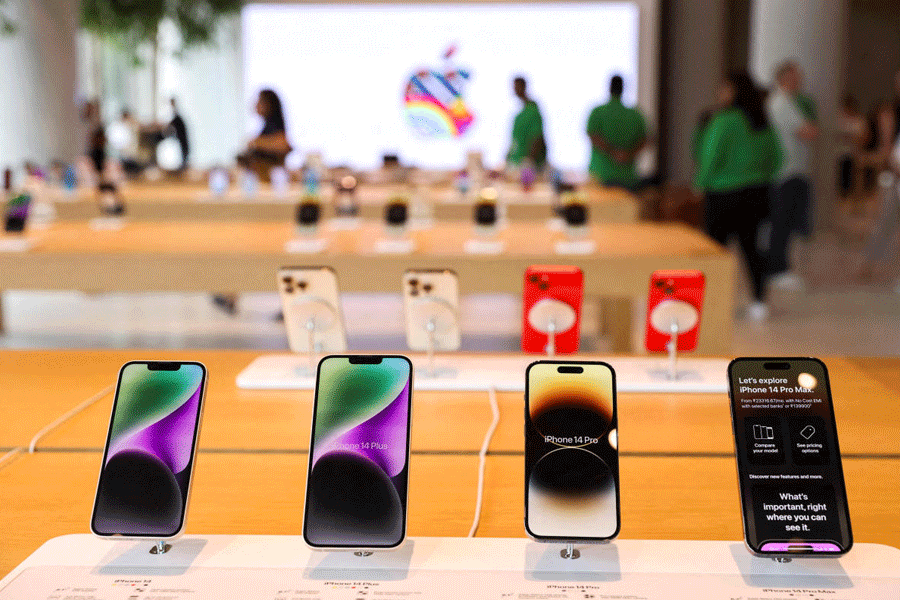The sheer scale and magnificence of it all will make you gasp. What is gargantuan from a few feet away lends itself to poetic delicacy once you close in a little, feeling it, touching it, soaking it all in. Works by Vikram Goyal Studio. The art entrepreneur himself was in town for a special preview, in what was his first showcase in Calcutta, at Burdwan Palace. Presented by Shalini Nopany and Pooja Goenka of 85 Lansdowne, the curation also features Vikram’s new lifestyle brand Viya, a fluid entity encompassing life in its entirety. We sat down with Vikram to learn more about his process and his dreams.
There couldn’t have been a better venue for this showcase in Calcutta...
I am really delighted with this space because so much of our work is rooted in heritage, history and India’s deep culture and then to have this kind of foil for our work, it couldn’t have been better.
Is this a one-of-a-kind showcase for you, given the setting?
Absolutely. There are many places such as these, many palaces, forts, all around India, but very few have been able to lend themselves commercially to contemporary design and art. So I think this is a great platform for anyone wanting to show contemporary work.
What we see is spectacular...
For the Studio, we focused on our repousse work. As you know, we work with sheet metal, and one of the signature techniques of our studio is repousse, where you kind of chip into sheets of metal on hot wax, from the back. So you only know what you’re chipping at after two months when you pick up the sheet and see what you have made. It’s quite extraordinary, this part of our heritage. There are deities and some more contemporary works, wall panels, and repousse on furniture, sculptures and vases. And then we have some of our other contemporary organic, collectible design furniture pieces.
For Viya, we’ve got the whole range. We, of course, work in metal, but there’s cane, rope, cotton, linen, and embroidery, anything as long as it’s handmade in India. It has to be artisanal, and everything is inspired by some part of India, whether it’s Indian mythology, a monument or a folk tale. The idea is that there are three parts of the Viya story. One is that it’s artisanal. The second is that it’s rooted in some Indian narrative. And, third is that it’s contemporary design. So, even though it’s made in India and there’s an Indian narrative, the design is international. Within that, we’ve got furniture, lighting, mirrors, tabletops and tissue holders. It’s kind of our version of eat, pray and love... a modern version.
You left a career in investment banking and plunged into entrepreneurship. What gave you the conviction?
You know, all that happens organically. I was with Morgan Stanley, an investment bank, in New York and Hong Kong, for six years and moved back to India in 2000. I was very keen to work with areas of indigenous excellence and use modern communication to get the messaging to the outside world. I co-founded a brand called Kama Ayurveda, an Ayurvedic cosmetic brand, which we sold out to a Spanish company. And then, soon after, I founded Vikram Goyal Studio.
I wanted to work with craft, and I liked brass because it was so versatile. I stumbled on it, kind of again organically, and started with one master craftsman and then moved on. I like it because it’s versatile. It’s also a colour and a sheen which we weren’t very used to. It’s kind of a poor version of gold. India has a deep history of artisanal heritage in brass, for ritual vessels and surface decoration. So, you had the artisan. There was a richness of craftsmanship already existing and I just wanted to use my design lens to see how we can make that skill relevant in today’s world.
But it was a risk...
I guess so. It was a risk, but you had to follow your (instincts). I was in my mid-30s then. It was a joy to wake up in the morning and go to work as it is now. It’s been a journey. You start with one. Then we used to outsource our work. Now we have our own set-up and we use what they call the karkhana workshop model. I’m not a trained designer, nor am I an artisan, but my interventions come from having this big workshop where we have designers, engineers, artisans and production managers. We are able to stretch the boundaries of design because it’s our own workshop. We can experiment and sample because it’s under our own four walls. And we are also able to stretch the boundaries in terms of scale, which is difficult to do when you’re outsourcing stuff. We are able to take risks, not only on the patterns and designs, but also on the scale of things. So, I’m quite pleased with where we’ve reached now.
And we launched Viya a year and a half ago. It’s been three years in the making and was kind of born during Covid. I actually published a book on the family’s collection of Shrinathji miniature paintings, and then we were talking to people around the world on Zoom. And I saw there was this great curiosity for India and Indian culture. I thought, why am I confining myself to these very large things in brass, these limited-edition things? Why not experiment with other materials, expand into different product categories, and change the design language, from very large to small? And yeah, I’m loving it.
Was it a conscious decision for you to reach a wider clientele?
I’m very conscious of the fact that we want it to be handmade, natural, and are very quality-conscious. And none of those things lend themselves very much to cheap... to a budget.
So our price point is way more accessible than the Studio is, but it’s still not mass, if you know what I mean, but it is definitely a wider audience.
I was very keen that I wanted to showcase the best of India internationally. So there were no shortcuts. And we’ve been very fortunate to be able to. We are now selling through some wonderful, very high-level, multi-brand platforms internationally.
That was what our journey was all about. It was very difficult for me to cut corners. I wanted to be creative and experiment with showcasing the best of what we have.
Typically, how long does it take to produce a Studio piece?
Typically, anything in the Studio takes six to 12 weeks. Viya also has metal, but the way we kind of separate is... in the Studio, we work with sheet metal, and most metal studios around the world work with cast metal. They’re casting and there are moulds. We get that material and roll sheets of brass. Then they are beaten to give it strength. And then they’re made into three-dimensional objects, which is very labour-intensive. It’s in our DNA to labour at something and be at it for two to three months on one piece.
It’s meditative...
It’s meditative. Especially in repousse because as you chip away, it depends on your breath and what you’re putting into it because you’re literally carving into the metal, from the reverse. You’re not seeing what you’re carving. You’re seeing it from the back. So it requires an extraordinary amount of skill, patience and peace of mind.
You’ve worked quietly over the last two decades, positioning your work globally. Considering you didn’t have a background in this, were there obstacles, and what has that journey been like?
My not having a background in design or being a designer myself, I didn’t see it as a hurdle, because I’ve been obsessed with design ever since I was a child. I grew up in New Delhi, which is rich culturally in the visual arts. My grandparents lived in Jaipur, and I travelled extensively throughout Rajasthan, also very culturally rich. So somehow I kind of grew up around these things and learned about them and learned to appreciate them. The hurdles (were)... it is kind of a very disorganised sector and we kind of wanted the master craftsman we worked with, to be self-sustaining, but it became a very difficult model (to adhere to). (Say) you’re dealing with clients internationally, and there’s a wedding in the family of the master craftsman, and everything is closed. It doesn’t work. Those were the initial production hurdles. That’s when we decided to set up our own workshop, where you’re able to control quality and timeliness. When you’re creating new things and experimenting so much, you’ve got to be very much in control of your own resources.
Tell us about Viya...
It’s a lifestyle brand. We started candles (too). One of our key designers said she was very interested in apparel. So I said, go ahead. That’s how it started. It’s good to have this wonderful team of mature designers.
Are you doing interiors?
I’ve just done my last interior in Chennai for a friend, I’m no longer doing interiors. Product design is much easier for me and dealing with what you want to create, having the liberty of being able to do what you want to do. It’s an incredible space that we’ve created and I’m very happy when designers use some of our pieces in those spaces. It’s great.
We are really living in dark times. What do you think the role of art is now?
I think the role of art is manifold. One is to use it to get people to think. It’s also to bring joy, and also it’s a linkage to telling a story and history. And, the future, the present. Art is something so difficult to quantify.
Either way, an artist is telling his or her own story visually. We feel we are at the confluence of art, design and craft. The way I separate it is, design is what is functional and art is not. So with our repousse work, we do both. We have all the wall panels which are non-functional and then we have the functional items like the furniture and accessories.
Do you like how art is being consumed nowadays?
You know, to each his own. People ask me what the trends are. I don’t believe in trends per se. There is no trend. I think people should be free to express themselves in whichever way they want. They can consume art or design or craft in any way they want. There is an interest in whatever way there is. For me, when I travel and look at contemporary art and hear the narrative behind it, sometimes it makes me think very hard about life and all its ups and downs, good and bad, past and present. For me, art is not just visual art. I view cinema as art. I view music as art.
Tell us a bit about your fabulous collaborations...
We have been working with Nina (Yashar) of Nilufar for a few years now and we have showcased at PAD, which is a gem of a show in London, at Berkeley Square. And we signed up with The Future Perfect and we showed at Design Miami. We had a collaboration with de Gournay and designed wallpapers based on our repousse artworks.
What are the dreams for The Studio and Viya?
We have got two great shows coming up. One at PAD, one in Design Miami/Paris, in the fall. And for Viya, we never say no. So it’s continuing (smiles).










